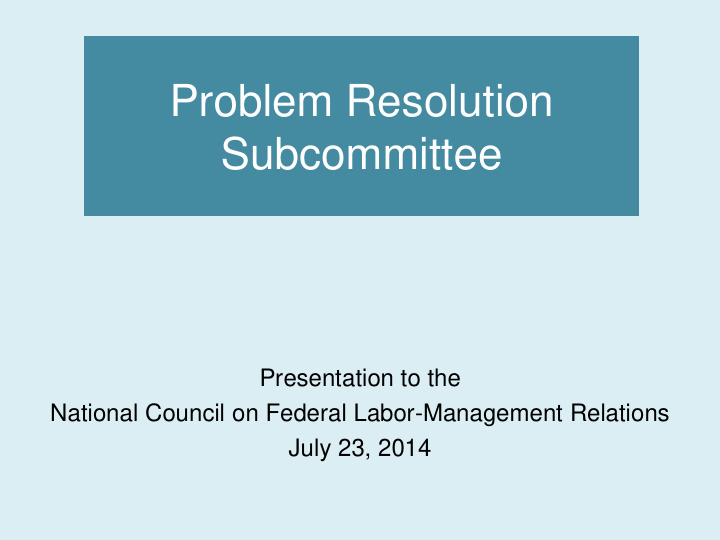



Problem Resolution Subcommittee Presentation to the National Council on Federal Labor-Management Relations July 23, 2014
Metrics Reports Working Group
Metrics Working Group Working Group Members OPM, USDA, VA NFFE, Seafarers Int’l Union FLRA 3
Metrics Working Group Working Group Meetings May 9, 2014 May 30, 2014 June 20, 2014 July 2, 2014 4
Metrics Working Group Reports 52 Reports Submitted for 2013 No Outstanding Reports 5
Metrics Working Group Common Themes Heavy Emphasis on Federal Employee Viewpoint Survey Results Labor-Management Relations Employee Satisfaction Little Emphasis on Agency Mission Accomplishment Some Identification of Specific Issues Little Emphasis on Measurement Little Connection Made Between Issues and Results 6
Metrics Working Group Common Barriers Lack of Understanding Distinction between Forums, PDI, Bargaining How to measure, what to measure, when to measure Relationship Issues Some Agencies Reporting Out that Still Have No Forums or No Functioning Forums Lack of Interest Irreconcilable Differences No need for change Communication Dealing with Other Issues Downsizing, restructuring, sequestration, shutdown 7
Metrics Working Group Best Practices DOC-PTO and POPA and NTEU Chapters 243 and 245 Mission Accomplishment - Increased telework, reduced space required to house employees, reduced energy usage Resulted in cost savings of more than $5 million USDA and AFGE, Local 3354 Labor-Management Relationship – Increased total bargaining unit employees covered by a forum by more than 6% (92.4% in 2012, 98.5% in 2013) Mission Accomplishment – Developed strategies to reduce call hold times within Rural Development Centralized Servicing Center. Improved Average Speed of Answer (“ASA”) by 46% as compared to FY 2012 8
Metrics Working Group Quick Start Recommendation December will be here soon! Before the next Council Meeting - Follow-Up Email to Agencies Reminding them of Available Metrics Training Resources NCFLMR Metrics Guidance NCFLMR Metrics Quick Tips Training Webinars Problem Resolution Subcommittee o FMCS/FLRA Assistance 9
Metrics Working Group Long-term Recommendations Develop Additional Online Training in Basic Areas Relationships/Distinctions between LM Forums, PDI, Bargaining How Can LMFs Help You? (Labor/Management) Revise Metrics Guidance/Process Emphasize Focus on Mission Accomplishment Emphasize/Require Union Participation in Report Create New Opportunities to Submit Information Expand LMF Reporting Tool to encourage individual forum participants (agency and union) to report on metrics related to mission accomplishment In addition to Current Process 10
Pre-decisional Involvement & Collective Bargaining Working Group
PDI & Collective Bargaining Web-based Modules addressing aspects of PDI & Collective Bargaining Frequently Asked Questions Posted on Council website (presented at March 19 meeting) Checklists Ready to post PDI Outcomes Ready to post PDI Models & Success Stories work in progress 12
PDI & Collective Bargaining Module 1: Frequently Asked Questions 13
PDI & Collective Bargaining Module 2: Checklists Adapted from checklists used by experienced LM Forums, including: Pre-PDI checklists (Management and Union) PDI Invitation checklist Response to PDI Invitation checklist PDI Expectations checklist 14
PDI & Collective Bargaining Module 2: Checklists 15
PDI & Collective Bargaining Module 3: Outcomes When parties have completed the PDI process, they often don’t know what happens next. Put the agreement in writing? How should the agreement be structured? Is there still a duty to bargain? This interactive module helps answer these questions. 16
PDI & Collective Bargaining Module 3: Outcomes 17
PDI & Collective Bargaining Module 3: Outcomes 18
PDI & Collective Bargaining Module 3: Outcomes 19
Labor-Management Forum (LMF) Reporting Tool Working Group
LMF Reporting Tool As reported in January 2014, results from the Reporting Tool prompted questions about the possibility of different perceptions between labor and management on the topic of pre- decisional involvement (PDI); Follow-up interviews with select pairs of respondents were conducted to learn more. 21
LMF Reporting Tool The interviews found that in some cases, labor and management do have different perceptions about: What is PDI? How should it work? Are there shared expectations for PDI outcomes? 22
LMF Reporting Tool (Conclusions) Likely reasons for divergent answers about the frequency of PDI include: Lack of trust, will, or interest Lack of training on LMF/PDI process Lack of discussion/agreement on a common definition of PDI and PDI process for that forum Failure to memorialize any agreed-upon definition or process for PDI Confusion about the interface between PDI and existing agreements related to “partnerships” Confusion about relationship between PDI and collective bargaining 23
LMF Reporting Tool (Conclusions) Despite the obstacles, some parties reported working through issues successfully using PDI. Contributing factors seem to include: Trust in their relationship Shared belief that PDI can have benefits: Early identification/resolution of issues can shorten any bargaining Input from employees, through their union representatives, can streamline work processes, save money, and make employees happier 24
LMF Reporting Tool (Updated Version) Based on input from this Council in March 2014, we have updated the LMF Reporting Tool by: Including questions that focus on PDI experiences and perceptions, and Improving the design to facilitate identification of LMFs To avoid the potential for confusion between this tool and agency metrics reports, we recommend distribution in early 2015. 25
Recommend
More recommend